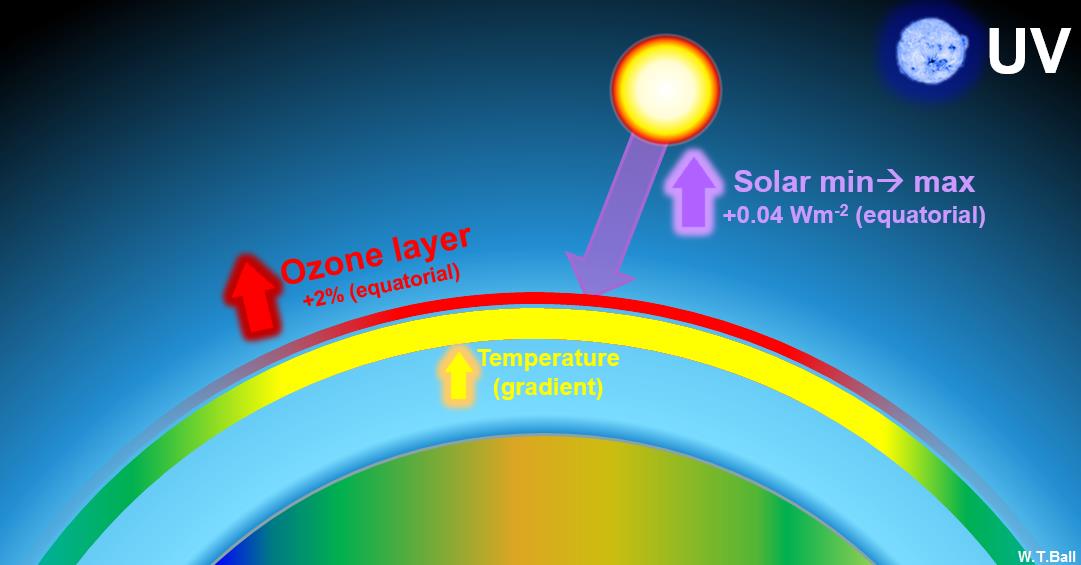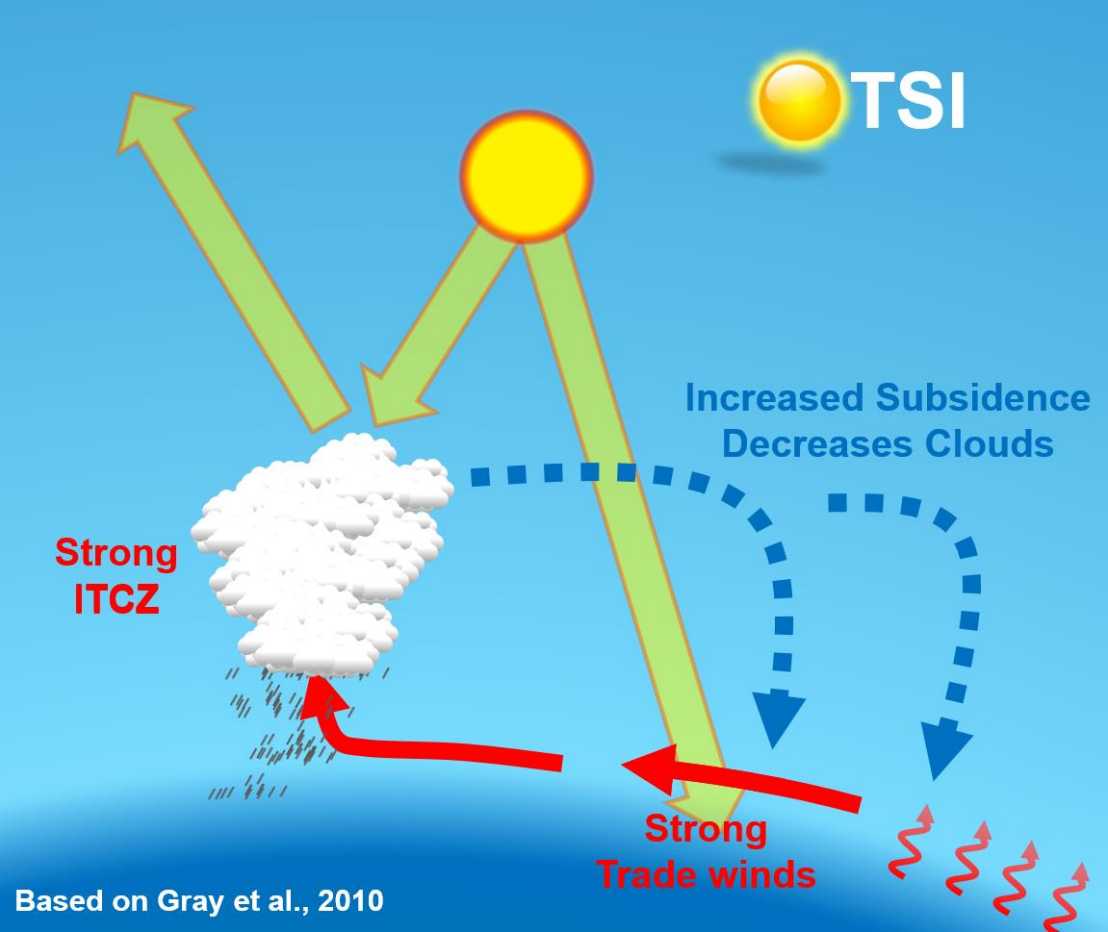Solar variability and climate

The Sun may influence climate in several ways that are current areas of intensive research. The main solar activity related drivers are solar irradiance and energetic particle precipitation. At the IAC, and in collaboration with PMOD/WRC, we deal with these mechanisms and here we explain the work we are undertaking to investigate the solar irradiance influence.
Solar irradiance is the electromagnetic energy from the Sun arriving at the top of the atmosphere. We consider it in two ways. The spectral solar irradiance (SSI) is the energy arriving at the Earth per unit wavelength (typically in Wm-2nm-1), e.g. in the ultraviolet (UV), visible and infrared. The total solar irradiance (TSI) is the integral of all SSI wavelengths (expressed as Wm-2). TSI is related to radiative forcing of the climate. Over the 11-year solar cycle, the TSI varies by 0.1%, or about 1.3 Wm-2. The solar irradiance is also thought to change on centennial time scales, and between 1700 and 2000 it is thought most probable to have increased by 1.3 Wm-2, though the uncertainty range encompasses changes of up to 4 Wm-2 and as low as no change. Current research suggests that the TSI changes since preindustrial times are not enough to account for much, if any, of the recent changes we have seen in the climate.

Nevertheless, one avenue of research we are pursuing at the IAC is to assess the impact of larger solar changes on centennial timescales, through the FUPSOL I and II projects in collaboration with the University of Bern (AND EAWAG, Oeschger Centre for Climate Change Research). There is a growing body of evidence from models and observations, that solar irradiance variability may have an impact on regional climate and weather. There are thought to be two pathways by which SSI can modify the climate. The ultraviolet component, at wavelengths shorter than 320 nm, is absorbed by ozone in the stratosphere above 20 km, and little UV reaches the surface. Relative to periods of quiet solar activity, at high activity levels, this absorption leads to heating in the upper stratosphere and results in a modification of the equator-to-pole temperature gradient, which has a consequence for mid-to-high latitude surface weather. The near-UV, visible and infrared SSI component i.e. wavelengths longer than 320 nm) reaches the land surface and ocean and, during periods of high solar activity, affects circulation patterns close to the surface and modifies temperature and precipitation patterns.

Our research into the impact of solar irradiance changes mainly focuses on the stratospheric pathway. We are analysing all aspects of this pathway: determining the magnitude of solar cycle changes as measured at the top of the atmosphere; refining our understanding of the impact that solar variability has on stratospheric chemistry, focusing primarily on ozone, but also on NOx and HOx chemistry, and temperature; how dynamics are affected by the Sun, both directly from photolysis and heating, and from resulting changes in chemical composition; and, finally how those dynamical changes propagate down to the surface and influence our weather and climate. Through the FUPSOL-II project, we are also interested in the impacts of solar variability on longer timescales than the solar cycle. We are investigating both the impact of a Sun that has larger underlying variability than has been observed to date, and also the impact on the ozone layer and climate that a deep grand solar minimum may have in the future, simulating climate in such a scenario from 1610 to 2200. The impact of these much longer timescales will be related to long, integrated, changes in the oceans, which may have a much more important role to play on climate than on decadal timescales. Through this work we should have a better understanding of the pathways and magnitudes of variability by which the Sun can drive the climate system. Our main modeling tool for this work is the chemistry-climate model SOCOL.
Recent results
Our recent results relative to the solar activity influence on Earth’s climate and ozone layer are listed below:
- Potential solar activity decrease in the near future is able to cool surface by about 0.3K, which will not dramatically compensate expected global warming caused by greenhouse gases. However, this process may delay or even cancel global ozone level recovery due to introduced limitations on the production of ozone depleting substances (external pageAnet at al., 2013call_made; external pageArsenovic et al., 2018call_made).
- Colder climate during the Dalton minimum can be explained only if the both volcanic eruptions and solar activity decrease are considered (external pageAnet et al., 2014call_made).
- The magnitude of the total solar irradiance change between Maunder minimum and present day minimum can reach 5 W/m2, which substantially exceeds the recently published estimations (external pageEgorova et al., 2018call_made).
- About a half of the global warming during first half of the 20th century is caused by the well-mixed greenhouse gases increase, while the increase of the weakly absorbed solar irradiance is responsible for approximately one third of the warming (external pageEgorova et al., 2018call_made).
- The magnitude of Spectral Solar Irradiance long-term variability obtained during NASA SORCE satellite mission is not supported by the observed ozone evolution (external pageBall et al., 2016call_made).
- Middle range energy electrons precipitating from the outer radiation belt are responsible for about a half of mesospheric ozone depletion by energetic particles, but in the stratosphere low energy (auroral) electrons dominates (external pageArsenovic et al., 2016call_made).
- The largest solar proton events of 874 CE can be identified from 10Be record, but not observable in the nitrate deposition (external pageSukhodolov et al., 2017call_made).
References:
Anet, J., E.Rozanov, S.Muthers, T.Peter, S.Bronnimann, F.Arfeuille, J.Beer, A. I. Shapiro, C. Raible, F.Steinhilber, and W.Schmutz, Impact of a potential 21st century “grand solar minimum” on surface temperatures and stratospheric ozone, Geophys. Res. Lett., 40, 4420–4425, doi:10.1002/grl.50806, 2013.
Anet, J., S. Muthers, E. Rozanov, C. Raible, A. Stenke, A. I. Shapiro, S. Brönnimann, F. Arfeuille, Y. Brugnara, J. Beer, F. Steinhilber, W. Schmutz and T. Peter, Impact of solar vs. volcanic activity variations on tropospheric temperatures and precipitation during the Dalton Minimum, Clim. Past, 10, 921-938, doi: 10.5194/cp-10-921-2014, 2014.
Arsenovic, P., E. Rozanov, A. Stenke, B. Funke, J.M. Wissing, K. Mursula, F. Tummon, and T. Peter, The influence of Middle Range Energy Electrons on atmospheric chemistry and regional climate. Journal of Atmospheric and Solar-Terrestrial Physics, 149, 180-190, doi:10.1016/j.jastp.2016.04.008, 2016.
Arsenovic, P., E. Rozanov, J. Anet, A. Stenke, T. Peter, Implications of potential future grand solar minimum for ozone layer and climate, Atmos. Chem. Phys., 18, 3469–3483, doi: 10.5194/acp-18-3469-2018, 2018.
Ball, W., J. D. Haigh, E. Rozanov, A. Kuchar, T. Sukhodolov, F. Tummon, A. V. Shapiro and W. Schmutz, High solar cycle spectral variations inconsistent with stratospheric ozone observations, Nature Geoscience, 9, 206-209, doi:10.1038/ngeo2640, 2016.
Egorova, T., W. Schmutz, E. Rozanov, A. I. Shapiro, I. Usoskin, J. Beer, R. V. Tagirov, and T. Peter, Revised historical solar irradiance forcing, Astronomy & Astrophysics 615, A85, doi: 10.1051/0004-6361/201731199, 2018.
Egorova, T., E. Rozanov, P. Arsenovic, T. Peter and W. Schmutz, Contributions of natural and anthropogenic forcing agents to the early 20th century warming, Frontiers in Earth Sciences, in press, 2018.
Sukhodolov, T., Usoskin, I., Rozanov, E., Asvestari, E., Ball, W., Curran, Mark A. J., Fischer, H., Kovaltsov, G., Miyake, F., Peter, T., Plummer, C., Schmutz, W., Severi, M., Traversi, R., Atmospheric impacts of the strongest known solar particle storm of 775 AD, in Scientific Reports, 7, 45257-45257, doi: 10.1038/srep45257, 2017.
